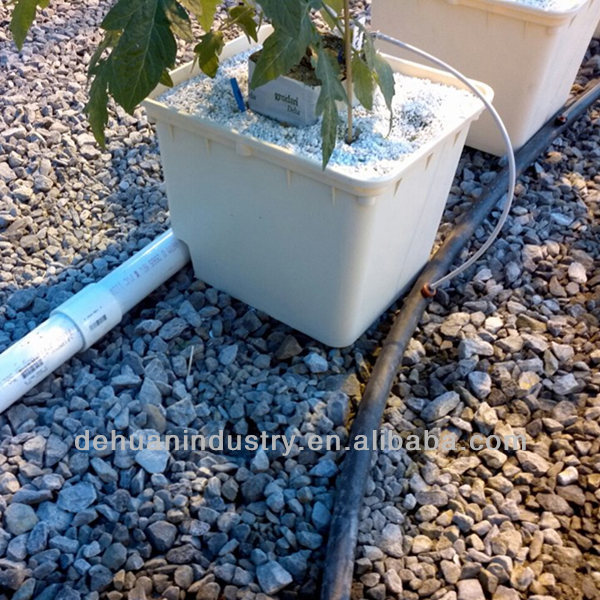

I've seen PVC structures, tables and the common "sawhorse" set-up. If your reservoir is in the same room, you'll have raise the buckets so gravity can do it's thing. I just put a slight angle on it by raising the long side of the pipes about 2" and the downward pipe that leads to the reservoir about 1". Since in this set-up, the reservoir is 2' lower than the system, it's easy to drain. Here's the layout, assembled in the room. The buckets are the same just a different color. The next pisture shows how the bato drain-plug fits into the PVC pipe. This way, the water always siphons out from the bottom and never leaves stale water in the bucket. Two elbows are combined for one drain fitting. Here's the bato bucket, you can see the reservoir. Now drill out holes for the bucket-drains. A 3/4" drill bit would be enough but I went a bit larger. I used a pair of pruning scissors to get a little groove into the PVC, so the drill bit with the pointy end would grip right away. 10' PVC pipe cost's less than $4 and they will cut it for you to size at Home Depot.įirst we measure and mark our PVC pipe where the hole for the drains will be drilled. The batos are designed to be drained by 1 1/2" PVC pipe, which means the drains plug right into the pipe which in turn stabilizes the bucket. Store price (without the light) would be about $750. The rows are 20" on center which fits the footprint of the 1K light and reflector I'm using. You can space them wider or closer, depending on how long you're planning to veg. In this FAQ, we build a 16 bucket system. You can design this system as big or small as you like. This is a grand total of $191.02! Pretty good savings if you ask me.įirst you'll have to measure your space and decide how many buckets you will want to use. MAG Pump: $30, but smaller pump would do.Feedline Links: $0.70 - $1.50 T, Elbow, shut-off valves, riser, endcaps 7 x misc.Feedline: $11 for 50', can also be bought in 10' for less than $5.OUCH! That might be the reason for the decline of the batos in the community. You might have seen the bato buckets in a system called "Eve's Garden", which is a "Brand" product and therefore costs about $350 for a 6 pot and up to $600 for a 12 bucket system. Batos have been around for years with proven results but lately haven't been seen that much.
#Bato bucket system plus#
The other big advantage over other drip systems like tube, tubbler or slab set-ups is that the plants are in individual containers that can be moved around, plus the (almost) 3 gallon container provides enough space for the root-mass. No more fear of power outage, the bato buckets have a 2l (about 1/2 Gallon) reservoir built in, that works as a wick system if nothing comes from above. It is a very efficient top-drip set-up, easy to use and very safe. Here is my photo-report on building a Bato-Bucket, also called Dutch-pots, system. Root zone is exposed to nutrient rich vapors.How do I Build a Bato-Bucket/Dutch-Pot System? Water is stored in a bucket and air stone is provided. It works based on combination of aeroponics and deep water cultivation principle.
#Bato bucket system install#
which much simpler to install in the backyard. Other type being simple DWC bucket system. This system require good pluming system, reservoir tank and automatic control system for smooth operation. water is continuously recirculated with the help of a siphon system. Here planting is done with the help of a net pot. One of the other type being recirculating deep water culture system. the drain mechanism provided in the bucket continuously remove the water allows fresh air to pass through root system improve cation exchange capacity of roots. Nutrient rich water is flowed through driplines into these system. here cocopeat / perlite/ vermiculate/ river sand is filled in a bucket with a preinstalled a flow and drain system. Most common setup being drip base semi closed system.

Dutch bucket, also known as Bato Bucket can be arranged in different configurations depending upon the plant, customer feasibility and resource availability.


 0 kommentar(er)
0 kommentar(er)
